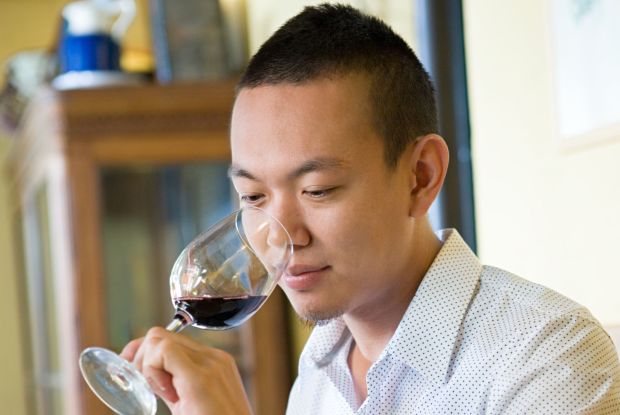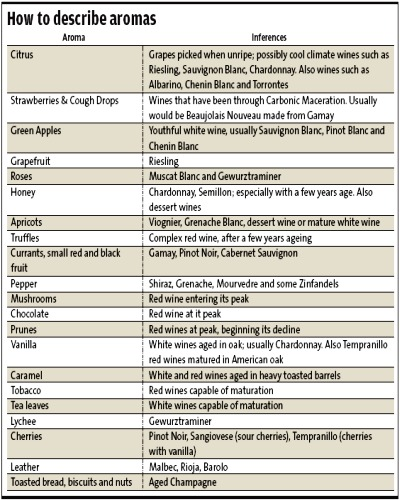Learn to taste wine like an expert.
HAVE you ever watched a wine expert taste a wine blind (label unseen), and then wonder how he or she names the wine correctly?
Good news is that almost anyone can do it. If you can describe your favourite dish – chicken rice, for example – with sensory terms (the fragrance of ginger and chicken fat in the plump, fluffy rice and the moist, tender, fatty meat), then you can describe wine.
With some training and knowledge you can make a pretty good guess on a wine’s origin and the grape variety. And possibly even identify the wine correctly – simply by looking, sniffing and tasting the wine.
Here’s how to do it.
First, review what we covered last month: the aspects of sight in wine. By inspecting a wine, one can make an educated guess about its age, the maturity of fruit, the growing temperature of the grapes (environment and climate), the soil type, the grape variety and even the wine making technique.
The next step is to develop your olfactory IQ so that you can pick up subtle scents in the wine that clues you into its variety.
Let’s try this exercise:
Get 10 paper cups and in each of them, place one of the following items.
a. a slice of lime
b. a strawberry
c. a grind of black pepper
d. a crushed ripe cherry
e. five drops of vanilla essence
f. 1 cubic centimetre of cigar tobacco
g. a small slice of pineapple
h. a star anise
i. a lychee
j. a tablespoon of plum jam
Label the cups, move them around so they are not in order and then line them up in a row. Now get the help of an assistant. Next, blindfold yourself.
Get your assistant to lift one of the cups to your nose and try to detect and identify the aroma.
Continue to do the same with all the cups. Rest for about an hour and return to the exercise.
Practise till you can correctly identify at least eight of the aromas. You will be surprised how fast you can train yourself to identify scents.
Now try identifying other fruits/spices/flavourings such as cashew nut, cinnamon, grass, mint, coffee, incense, ginger, pencil shavings, wax, bubble gum, soya sauce, tomato, yoghurt, cheese, Shiitake mushroom, prune, bean, carrot, cucumber, papaya, banana, pomelo, dried fruit, jackfruit, rambutan, five spice, and pandan leaf. Indeed, many Asian herb, spice and fruit aromas can be found in wine!
Smells abound all around us so there are many opportunities to hone your sense of smell. For example, when you are in the shower, take time to smell the different scents in your shampoo, conditioner, moisturiser, toothpaste, etc.
Likewise, you’ll find a plethora of sensory delights in your refrigerator. Pick up a fruit or a condiment and take a sniff. I do this all the time. Today, I took a sniff of starfruit and then enjoyed the aromas of melon and chocolate ice cream.
A party to practise
Acquiring the skills of a wine taster need not be laborious or boring. One way is to have fun and to do it with friends. Get together with, say, three other people, each bringing to the party a certain wine style. The wines should be bagged so that when poured, no one will know the varietal. Everyone sits down to sniff and sip the wines, discuss its aromas and flavours and then guess its variety.
Begin with wine varieties such as Pinot Noir, Syrah, Sauvignon Blanc and Chardonnay.
Progress to comparing differences in wine maturity (same wine from different vintages); same varietal but from different regions (California Meritage versus Australian Cabernet Sauvignon blend versus Bordeaux or Syrah versus Shiraz, etc.)
A point to note is that in assessing wines, wine experts place more importance on the “smell” of wine than its taste. We “taste” flavours via our olfactory senses. When the wine is in the mouth, the taster sucks in air so that any scents and aroma molecules can be drawn up to the olfactory bulb in the brain to be identified.
The more wines you are exposed to, the better you will become as a wine taster. You will find that in the beginning, you are able to identify grape varieties of wines without looking at the label.
Later, if you continue your “practice”, you will be able to tell if the wine comes from a temperate or warm climate. Further down the road, you will be able to identify the region the wine comes from. And one day, you might just be able to name the producer, the vintage and become just like those expert wine tasters we mentioned at the beginning of the article.
To be able to identify wines “blind” you have to expose yourself to many kinds of wines and become accustomed to the particular scent/aroma of each wine style.
The table, “How to describe aromas”, may help get you on track to becoming a discriminating wine taster. Do note that aroma vocabulary is not an end in itself – rather, use it as a tool to evoke memories, remember experiences and the wines you like or even dislike!
Edwin Soon is a qualified oenologist and has run wine shops and worked as a winemaker in various countries. He now writes and teaches about wine around Asia.
Exciting wine event
CALLING wine lovers! The 3rd South-East Asia Best Sommelier Competition takes place at The West in Kuala Lumpur from Nov 5 to 8. The competition, hosted by the president of the Sommelier Association of Malaysia and chairman of the South-East Asia Sommelier Alliance is open to F&B directors, sommeliers,hotel managers and the public.
There will be a host of other events such as master classes and seminars associated with the competition, among them, the“Asian Street Food Pairing Experience”and “Journey through the Provence Wine Route.” The Provence & Alsace Seminar sare free for trade members, with limited seats available to the public at RM80.
Admission to the Grand Finals of the competition on Nov 7 at 2.30pm is free.
For more information, please e-mail:somlayinfo@gmail.com.

